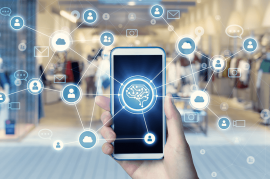Machine learning for next-best offers

We all have our habits
and routines. Some enjoy jogging first thing in the morning, while others would
rather stay up late watching their favorite show.
As discouraging as it
may seem, our daily lives are full of repetitions. Most people take the same
route every day when they commute, drink the same coffee on their way to work,
and then greet the same friendly or not-so-friendly face at the reception desk.
Similarly, when it
comes to shopping habits, some have their dedicated shopping day and a list of
recurring items they buy every time. Others go with the flow, look for the best
deals whenever they find some time to shop, not even looking at the brands or
what they chose in the past.
So why not train a machine learning model to predict the next purchase a given customer will make and estimate when this transaction will take place?
Machine learning strikes again
There are two approaches to the challenge of creating a next-best offer recommendation based on the customer’s purchase history:
- Searching for general (macro) shopping preferences of customers and essentially returning global best-selling items as recommendations
- Analyzing sequential customer behaviors (micro) – perhaps they have recently started to buy some specific products — and avoid any global bestsellers at all?
The great thing about AI/ML is that it is possible to combine multiple approaches and make the solution dynamically choose the best recommendation based on the model results and some configurable parameters. In this case, a popular AI solution is the way to go — deep neural networks.
In a nutshell, these are the algorithms that attempt to recreate the way the information is processed and remembered by the human brain. By feeding a large volume of historical baskets as an input, it can detect patterns in how particular customers tend to buy. If developed and tuned well enough, it is possible to make a high-accuracy prediction of what each customer is most likely to buy in their next transaction.
Skipping the technical details, a model like that can produce a personalized ranking of historical products for each customer. The ranking is based on the “score” of the products. The model training is based on the observation that a given customer prefers a product that they purchased over some other product they didn’t. The training process is based on processing several thousands of such pairs. This way of recommendation generation can be found in the literature as a Bayesian recommendation system, which is one of the most popular recommendation systems as of now.
But how to use it?
If you can predict the most likely contents of the next transaction and when is it going to happen, this creates a vast spectrum of marketing or loyalty opportunities.
Marketers may use this data in a number of possible ways:
- Creating an offer just for members who are likely to buy in the next three days.
- Targeting a cross/up-selling campaign for promoted products at customers who have other products from the same category or brand predicted as a likely purchase in the next transaction.
- Extra bonus/reward for members who purchase before their predicted next transaction date.
- Differentiating campaign communication based on the member’s next basket predictions.
- “Come-back” offer for members who have not purchased anything in 10 days after their next predicted purchase date.
- Adding gamification elements to members who tend to “follow the predicted pattern” of purchases – perhaps adding additional loyalty points type, progress bars, achievements, badges…?
These are just a few examples of how the transaction time and content prediction can be used to create a genuinely engaging loyalty program. With the combination of other information on the customer – segment assignments, predicted lifetime value, demographic information… the possibilities are nearly endless.
To learn more about AI and machine learning, please visit the resources on the Comarch site.
The post Machine learning for next-best offers appeared first on Marketing Land.
From our sponsors: Machine learning for next-best offers




